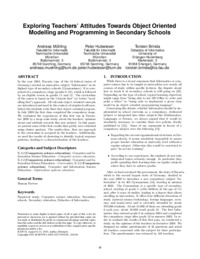Exploring teachers' attitudes towards object oriented modelling and programming in secondary schools Publikationsdatum:
Zu finden in: ICER 2010 (Seite 59 bis 68), 2010
|
 |
 Diese Seite wurde seit 5 Jahren inhaltlich nicht mehr aktualisiert.
Unter Umständen ist sie nicht mehr aktuell.
Diese Seite wurde seit 5 Jahren inhaltlich nicht mehr aktualisiert.
Unter Umständen ist sie nicht mehr aktuell.
 Zusammenfassungen
Zusammenfassungen


In the year 2004, Bavaria (one of the 16 federal states of Germany) started an innovative subject "Informatics" in its highest type of secondary schools (Gymnasiums). It is comprised of a compulsory stage (grades 6--10), which is followed by an eligible course in grades 11 and 12. The curriculum of the course is based on the "objects first" (or better "modelling first") approach. All relevant object-oriented concepts are introduced and used in the context of standard software, before the students write their first object--oriented program. In July 2009 the first class completed the compulsory stage. We evaluated the experiences of this first run in December 2009 by a large scale study about the teachers' opinions about and attitude towards this new subject. In this paper we present some of the first results that partly were obtained using cluster analysis. The results show, that our approach to the curriculum is accepted by the teachers. Additionally, we used the results of clustering to identify typical response patterns, leading to a characterization of the teachers.
 Dieses Konferenz-Paper erwähnt ...
Dieses Konferenz-Paper erwähnt ...
 Anderswo finden
Anderswo finden
 Volltext dieses Dokuments
Volltext dieses Dokuments
 |  Exploring teachers' attitudes towards object oriented modelling and programming in secondary schools: Fulltext at the ACM Digital Library ( Exploring teachers' attitudes towards object oriented modelling and programming in secondary schools: Fulltext at the ACM Digital Library ( : :  , 352 kByte; , 352 kByte;  : :  Link unterbrochen? Letzte Überprüfung: 2020-11-28 Letzte erfolgreiche Überprüfung: 2020-08-28) Link unterbrochen? Letzte Überprüfung: 2020-11-28 Letzte erfolgreiche Überprüfung: 2020-08-28) |
 Anderswo suchen
Anderswo suchen 
 Beat und dieses Konferenz-Paper
Beat und dieses Konferenz-Paper
Beat hat Dieses Konferenz-Paper während seiner Zeit am Institut für Medien und Schule (IMS) ins Biblionetz aufgenommen. Beat besitzt kein physisches, aber ein digitales Exemplar. Eine digitale Version ist auf dem Internet verfügbar (s.o.). Aufgrund der wenigen Einträge im Biblionetz scheint er es nicht wirklich gelesen zu haben. Es gibt bisher auch nur wenige Objekte im Biblionetz, die dieses Werk zitieren.











 Biblionetz-History
Biblionetz-History